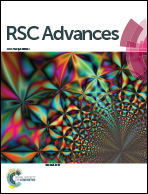Regio- and stereoselective synthesis of novel isoxazolidine heterocycles by 1,3-dipolar cycloaddition between C-phenyl-N-methylnitrone and substituted alkenes. Experimental and DFT investigation of selectivity and mechanism†
Abstract
A series of isoxazolidine heterocycles was synthesized through the 1,3-dipolar cycloaddition (13DC) reaction of C-phenyl-N-methylnitrone with different substituted alkenes. The structures and stereochemistry of the cycloadducts were determined by spectroscopic methods. These 13DC reactions are characterized by complete regioselectivity and high stereoselectivity. The molecular mechanism, reactivity and selectivity of these 13DC reactions have been investigated by means of transition state theory and reactivity indices derived from conceptual DFT using DFT methods at the B3LYP/6-31G(d,p) level of theory. The obtained results indicate that these cycloaddition reactions take place through a one-step synchronous mechanism with a non-polar mechanism and high activation energies. The theoretical results are in agreement with the experimental findings.



 Please wait while we load your content...
Please wait while we load your content...